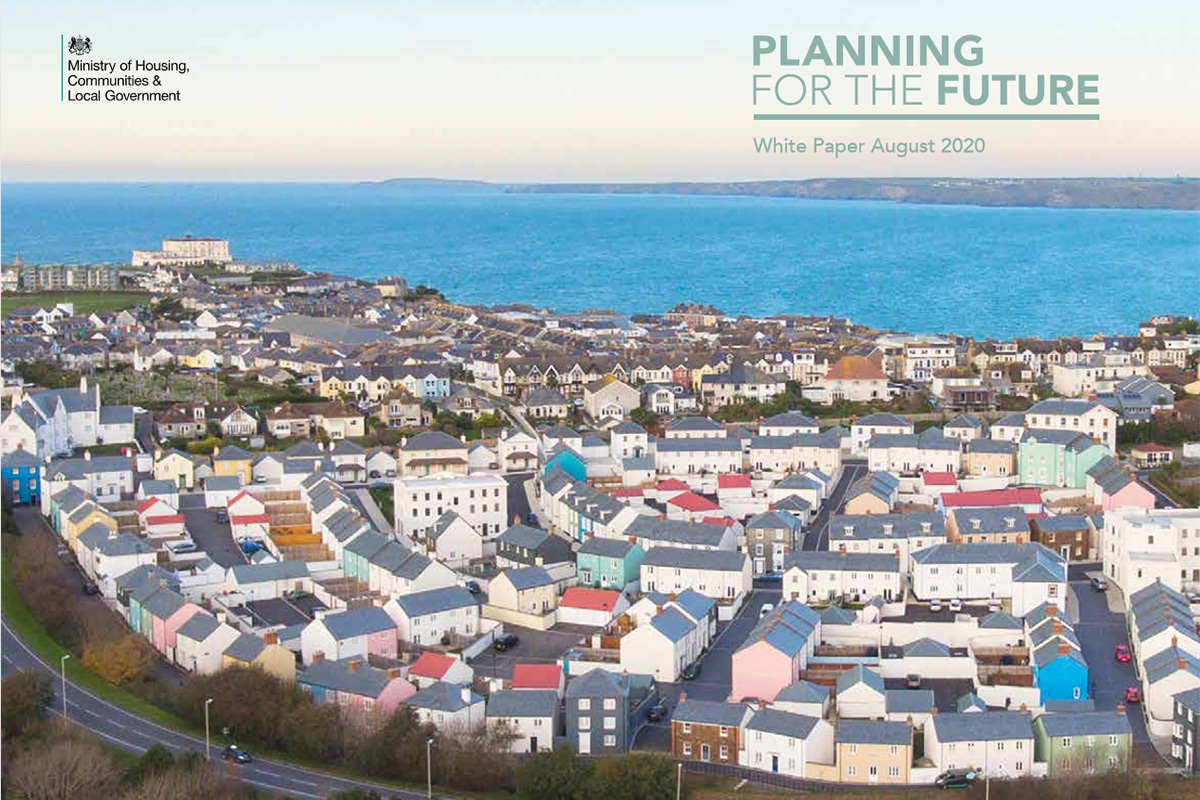Planning White Paper: how will the government’s overhaul change the planning system?
Last week the government published its 84-page Planning for the Future document. The new Planning White Paper puts forward a vision to radically overhaul England’s current planning system and replace it with zonal planning, centralised decisions and new local design codes. Nathaniel Barker takes an in-depth look at what is being put forward and the difficulties in implementing such wide-ranging reforms
The Planning White Paper – published on Thursday last week and titled Planning for the Future – is the government’s blueprint for ripping up England’s post-war planning rulebook and replacing it with a radically new system.
The immediate reception has been mixed to say the least and fears over the effects of the new measures abound. Labour leader Keir Starmer branded the document “a developers’ charter”, while others declared that it could pave the way for a new generation of slum housing.
Prime minister Boris Johnson was forced to defend the “long-overdue” changes amid reports of a Conservative backlash.
To cut through the noise, we have taken an in-depth look at the major policy changes with planning experts and assess what their implementation could mean in practice.
It is important to point out first that the reforms put forward in the Planning for the Future document are a long-term project. The government published a separate consultation document alongside the white paper, setting out more immediate measures to change the current planning system – which are set to have a big effect on affordable housing in the shorter term.
However, the Planning for the Future proposals have far more hurdles to get over before they become law.
Victoria Hills, chief executive of the Royal Town Planning Institute, tells Inside Housing that the significant changes “all require primary legislation” and Matthew Spry, senior director at planning consultancy Lichfields, expects it will be “several years” before the new arrangements are in place.
Housing targets
One really significant departure from the existing system is that under the new planning regime envisioned by ministers, government will dictate how many homes are built in each area. For decades, councils or regional authorities have calculated the number of homes they need as part of their local plans and then decided the number they feel can actually be delivered based on land constraints in the area, such as areas of outstanding natural beauty which cannot be built on.
But the white paper proposes that Whitehall dictates to each local authority how much housing it must deliver over the next decade, taking the 300,000-a-year national target as a starting point and including a centrally made decision about what is realistically deliverable. The figures will be based on levels of unaffordability, so more expensive areas will likely get higher targets. “This is a top-down approach rather than self-determination,” says Jan Bessell, strategic planning advisor at law firm Pinsent Masons. “Doing this at a national level with a standard method is arguably one of the boldest steps in the whole white paper,” Mr Spry adds.
The government has indicated that these targets will be “binding” though, as yet, detail on potential sanctions has been scant. At the same time, the duty to co-operate will be scrapped, meaning councils with high targets will find it harder to strike deals with their neighbours to take on some extra development.
The government’s method for calculating these figures must be watertight for the system to work properly, notes Mr Spry. Proposals on tweaking the standardised methodology for calculating housing need were also published last week. He also points out that it will mean “government is now ultimately responsible for the amount of development that is planned for” – in other words, communities angry about perceived over-development in their area will focus that displeasure directly at ministers.
Land categorisation
Much of the discussion surrounding the white paper has so far centred on its proposals for a new approach to land categorisation, which represents a step towards a zonal planning system.
Unlike the current regime where local authorities are required to demonstrate a five-year supply of land for housing, they would now need to divide all sites in their area into one of three categories: protected, renewal and growth. This is how councils will decide where the housing they have been told to build by the government will go.
Protected is as it sounds, while in growth areas developers would get automatic planning permission. Some commentators have voiced concern about the quality of homes delivered through this route.
“There are ways it could be effective and sustainable and ways it could deliver a lot of conflict,” muses Ms Bessell. “It could deliver unregulated development which is just about volume numbers – some would say risking slums of the future. I don’t think it’s at either of those ends.”
For her part, Ms Hills argues that it is “overly simplistic to put all the land in the country into three categories”. What label, she asks, should be attached to the suburbs? The case could be made that these areas are often ripe for greater density, though the people living there may well disagree.
However, deciding which sites should be protected will perhaps be less of a challenge for local authorities “than setting the tests for development where that does apply,” says Mr Spry. Deciding density and design standards for renewal areas – which could include most urban land – “will be the most difficult bit,” he predicts.
Ms Jessell agrees that the renewal category will likely have the widest scope and be most controversial – potentially paving the way for carte blanche estate regeneration, for example.
Local plans
The role of local plans will be dramatically revised under the proposed new system. Currently, these are the route through which councils decide how much housing will be built in their areas and where.
Ministers want to scale back or streamline these aspects of local plans – partially through measures outlined above – while significantly beefing up their role in other respects. Most importantly, local plans will become the primary vehicle for community engagement with planning policies and development.
At the moment most of this process happens “downstream”, Ms Hills explains, with residents commenting on individual planning applications. “Things will be agreed at the local plan stage, and the community won’t be able to have a say three years down the line at the development stage,” she adds. Of all the white paper’s proposals, she predicts this will be the area “that will vex local politicians and communities most”.
Ms Bessell agrees that people are unlikely to be satisfied with exchanging the ability to object to individual schemes for greater engagement earlier on in the planning process. Involving people in the early decision-making “could be a very good thing,” she adds, but notes that to make it work “you’ve got to capture the imagination of communities to take an active role”. That, she argues, “is a real skill and requires investment, technology and time”.
At the same time, the government intends to legislate so that local plans must be developed within two-and-a-half years – the current average is seven. The logic, Mr Spry explains, is that the “process and evidential hoops” associated with preparing local plans can be stripped out in favour of “more heavy lifting” in terms of actual specific policies on matters like housing density.
Nevertheless, he says, writing up a local plan which addresses all the detailed policy questions associated with development “becomes a really big task”, and Ms Hills is convinced that “you’re going to lose some engagement somewhere along the line”.
Design codes
An essential aspect of the new-look local plans will be their design codes. Councils will need to prescribe what they want from housing delivered in their areas, from aesthetics to transport links to energy efficiency credentials and everything in between.
This will be the primary lever for ensuring homes built in growth and renewal areas are good quality and is intended to give developers certainty over what is acceptable. It marks a considerably enhanced role for design codes, which Ms Bessell says currently carry only “relatively weak” influence in the planning decision process and tend to be piecemeal.
Ms Hills says the use of design codes to uphold development standards “puts a big expectation on local areas” and that council design teams producing the codes “are going to need some support”. Ms Bessell agrees the approach “is very reliant on these design codes really delivering” and says that ensuring they lead to a drive up towards better standards rather than a drive down to the minimum will be a challenge.
At the same time, to successfully speed up the system as ministers intend, Mr Spry notes that the codes will need to be highly specific in order to avoid back and forth between councils and builders over the details.
Developer contributions to affordable housing and infrastructure
The white paper’s ruminations on developer contributions – the mechanism through which affordable housing and other public benefits are secured from housing schemes – have also garnered significant attention. The government wants to scrap the Section 106 planning agreement and the Community Infrastructure Levy (CIL) and replace them with a new flat-rate Infrastructure Levy. Tied to final development values, it moves closer towards a land value capture approach to developer contributions.
Section 106 “has been successful” at securing large sums and numbers of affordable homes from developers, says Ms Bessell, but “often the time and money that goes into delivering this is disproportionate”.
“I don’t think anyone would say Section 106 and CIL are perfect, but whatever you replace that with, however you dress it up, it has to deliver affordable housing,” adds Ms Hills.
The government insists that the new system will deliver “at least as much – if not more” onsite affordable housing, but there are some concerns. Mr Spry says that while the Infrastructure Levy “does have the potential to capture more value”, it will be technically difficult to make that a certainty. “The levy still relies on judgements about benchmark land values which sound simple but in practice are difficult to judge,” he explains.
“The other thing which is an ongoing issue is that the cake can only be cut so many ways,” argues Ms Hills. “Layering on additionality of things planning can deliver will mean it comes down to choices. Net zero, affordable homes, schools, infrastructure [and] healthcare all cost money and pushing all that on a levy and thinking that will be delivering everything is not going to be the case.”
Perhaps most importantly, the government is proposing to set the Infrastructure Levy nationally “at either a single rate or at area-specific rates”. If it is the former, this could pose serious problems for lower-value areas. The same rate of levy will provide much more value in Cambridge than in Teesside, where margins are much tighter, severely limiting the resources available for good-quality affordable housing, Ms Bessell warns. “It will have the opposite effect of levelling up and embed inequalities and that is a real concern.”
Digitalisation
While not as headline-grabbing as some of its other proposals, measures outlined in the white paper to digitalise the planning system could be seismic. Many will be familiar with the innumerate unwieldy documents and drawings attached to planning applications on council portals – the government wants to move away from that.
Local plans should be “based on the latest digital technology”, the white paper says, with much greater use of data. Meanwhile, it envisions that “new digital engagement processes will make it radically easier to raise views about and visualise emerging proposals while on the go on a smart phone”.
These changes are “long overdue” says Ms Bessell, and done well “could truly make the system accessible” and revolutionise public involvement in planning, playing a crucial role in some of government’s other proposals discussed above. The impact on the profession, she says, could be similar to the radical advancements in science facilitated by the Human Genome Project.
Ms Hills – whose organisation has long called for greater use of technology in planning – welcomes the sentiment, but adds: “Well, my goodness, they’re going to need to resource that.”















